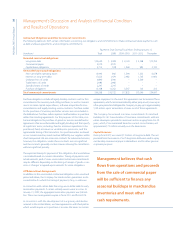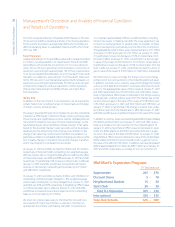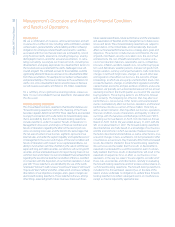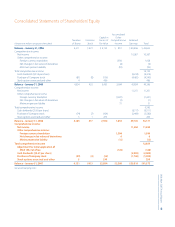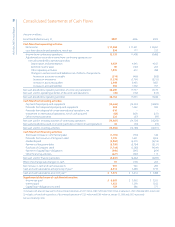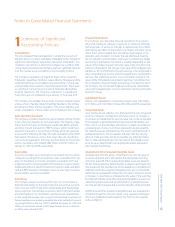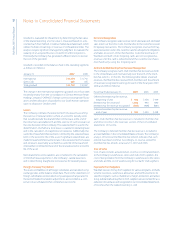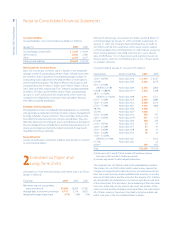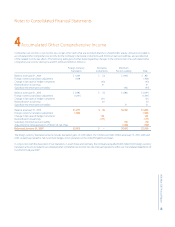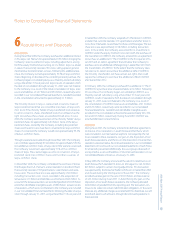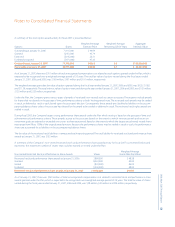Walmart 2007 Annual Report Download - page 46
Download and view the complete annual report
Please find page 46 of the 2007 Walmart annual report below. You can navigate through the pages in the report by either clicking on the pages listed below, or by using the keyword search tool below to find specific information within the annual report.
Wal-Mart 2007 Annual Report 44
Goodwill is evaluated for impairment by determining the fair value
of the related reporting unit. Fair value is measured based on a dis-
counted cash ow method or relative market-based approach, which
utilizes multiples of earnings or revenue of comparable entities. The
analyses require signi cant management judgment to evaluate the
capacity of an acquired business to perform within projections.
Historically, the Company has generated su cient returns to recover
the cost of the goodwill.
Goodwill is recorded on the balance sheet in the operating segments
as follows (in millions):
January 31, 2007 2006
International $13,454 $11,792
Sam’s Club 305 305
Total goodwill $13,759 $12,097
The change in the International segment’s goodwill since scal 2006
resulted primarily from the consolidation of Central American Retail
Holding Company (“CARHCO”), foreign currency exchange rate uctu-
ations and the allocation of goodwill to our South Korean operation
upon its disposal in October 2006.
Leases
The Company estimates the expected term of a lease by assuming
the exercise of renewal options where an economic penalty exists
that would preclude the abandonment of the lease at the end of
the initial non-cancelable term and the exercise of such renewal is at
the sole discretion of the Company. This expected term is used in the
determination of whether a store lease is a capital or operating lease
and in the calculation of straight-line rent expense. Additionally, the
useful life of leasehold improvements is limited by the expected lease
term or the economic life of the asset. If signi cant expenditures are
made for leasehold improvements late in the expected term of a lease
and renewal is reasonably assumed, the useful life of the leasehold
improvement is limited to the end of the renewal period or economic
life of the asset.
Rent abatements and escalations are considered in the calculation
of minimum lease payments in the Company’s capital lease tests
and in determining straight-line rent expense for operating leases.
Foreign Currency Translation
The assets and liabilities of all foreign subsidiaries are translated using
exchange rates at the balance sheet date. The income statements of
foreign subsidiaries are translated using average exchange rates for
the period. Related translation adjustments are recorded as a com-
ponent of accumulated other comprehensive income.
Revenue Recognition
The Company recognizes sales revenue net of sales taxes and estimated
sales returns at the time it sells merchandise to the customer, except
for layaway transactions. The Company recognizes revenue from lay-
away transactions when the customer satis es all payment obligations
and takes possession of the merchandise. Customer purchases of
Wal-Mart and Sam’s Club shopping cards are not recognized as
revenue until the card is redeemed and the customer purchases
merchandise by using the shopping card.
Sam’s Club Membership Fee Revenue Recognition
The Company recognizes Sam’s Club membership fee revenues both
in the United States and internationally over the term of the mem-
bership, which is 12 months. The following table details unearned
revenues, membership fees received from members and the amount
of revenues recognized in earnings for each of the scal years 2007,
2006 and 2005 (in millions):
Fiscal Year Ended January 31, 2007 2006 2005
Deferred membership fee revenue,
beginning of year $ 490 $ 458 $ 449
Membership fees received 1,030 940 890
Membership fee revenue recognized (985) (908) (881)
Deferred membership fee revenue,
end of year $ 535 $ 490 $ 458
Sam’s Club membership fee revenue is included in membership
and other income in the revenues section of the Consolidated
Statements of Income.
The Company’s deferred membership fee revenue is included in
accrued liabilities in the Consolidated Balance Sheets. The Company’s
analysis of historical membership fee refunds indicates that such
refunds have been nominal. Accordingly, no reserve existed for
membership fee refunds at January 31, 2007 and 2006.
Cost of Sales
Cost of sales includes actual product cost, the cost of transportation
to the Company’s warehouses, stores and clubs from suppliers, the
cost of transportation from the Company’s warehouses to the stores
and clubs and the cost of warehousing for our Sam’s Club segment.
Payments from Suppliers
Wal-Mart receives money from suppliers for various programs, primarily
volume incentives, warehouse allowances and reimbursements for
speci c programs such as markdowns, margin protection and adver-
tising. Substantially all payments from suppliers are accounted for as a
reduction of purchases and recognized in our Consolidated Statements
of Income when the related inventory is sold.
Notes to Consolidated Financial Statements


